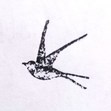Hûw Steer's Blog, page 3
June 15, 2025
Glup: A Star Wars Story
There is a concept in fan culture. It began in relation to Star Wars but has since spread across the nerd world. It began on Tumblr, in the distant past of 2020 – well, I say ‘began’, but it had been around for an awful lot longer, but not under this name. It is in many ways a cornerstone of nerd culture. It is the concept, dear readers, of Glup Shitto.
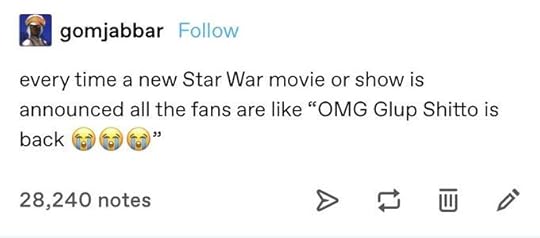
Glup Shitto: the character that nobody else has heard of, the character whose inclusion in two seconds of an otherwise completely unrelated trailer drives a handful of fans absolutely mad. The obscure, the underrated, the just plain weird. It’s a concept/trope that I absolutely adore. Firstly, ‘Glup Shitto’ is absolutely a name that George Lucas could have used for a Star Wars character: this is a man who once tried to name a villain ‘Darth Icky’ (seriously), and who did name Darth Maul’s brother ‘Savage Oppress’. He was a bad guy. You’d never have known, would you?
But more than that: in any big bit of media like Star Wars or Doctor Who, in any series of films or books or games, there are always those minor characters, those background extras, those one-off appearances. And in any fanbase there is always, always someone for whom that incredibly niche character is just the best thing on two to six legs, someone who’s a die-hard fan of that one weird alien in that one scene. And Star Wars is notorious – not alone, but famous – for there being some comic or game or other random piece of media for every single one of these characters. There is a surprisingly good book which follows the story of each and every one of the aliens in the Mos Eisley Cantina montage, and that’s just the tip of the iceberg. There is always a weirdo’s weirdo lurking in the pages of some ancient tie-in novel, just waiting to be discovered.
I am one of those weirdos. The more universes I think of the more Glups I realise I myself have, from Transformers to Warhammer to Star Trek and plenty more besides. Because when I like a thing I tend to dive straight in: I read the books, I trawl the wikis, I find the forgotten tie-in games. And Star Wars has been there since I was a kid, this vast universe full of weird characters brought up once and never seen again.
As I remembered last week, when I reread some old books, and found my own Glup Shitto waiting for me.
Cast your minds back to 1979, dear readers, when Star Wars was but a baby, a single film and nothing else. Almost nothing else. Because even then, just a year after the first film’s release, the Star Wars universe was expanding. Splinter of the Mind’s Eye, a book/comic that I’ll probably write a full post about some day, was the first piece of original spinoff fiction; comics were already being published. Never mind the next actual film: the Star Wars galaxy was vast already.
1979: the year that the second original Star Wars book was released – the first of the Han Solo Adventures by Brian Daley.
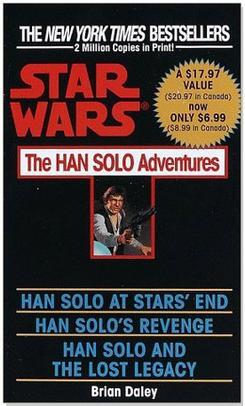
This trilogy is exactly what it says on the tin: Han Solo and Chewbacca, and a motley assortment of side characters, getting into shenanigans before Star Wars actually starts. They’re really fun books. Han and Chewie shoot around the Corporate Sector, pulling off heists, rescuing prisoners, and generally having their efforts to secure a fat profit undermined by their own tarnished hearts of gold. Because Han and Chewie are among the archetypes of loveable scoundrels, and Daley’s Adventures absolutely capture that and their characters perfectly. Which is pretty damn impressive given he only had one film’s worth of material to work from – later Star Wars expanded media has vast reams of story to pull from to get their characters right, but Daley pretty much nailed Han and Chewie first try. Hats off, Brian.
(As an aside, current Star Wars fans may have picked up on something in that last paragraph: yes, the Corporate Sector, setting of Andor, which I really need to watch and is apparently the best bit of Star Wars media… well, ever, originates in these books.)
I read these books as a kid. I reread them the other week. And it was in these pages that I rediscovered my Glup Shitto. Because among those side characters was the tiny, childish supercomputer Blue Max, brought onto the Falcon by our roguish heroes to hack into a prison and sticking around for two further books by dint of being a) adorable and b) very useful. But Blue Max was just a computer, basically: a blue box with a tiny USB arm. Blue Max couldn’t get around by himself. Blue Max required the services of an elderly but experienced old labour droid. A droid who had been everywhere, done everything; a slow, solid unit of a robot who was utterly dependable and, while sluggish, surprisingly clever. A droid in whose chest compartment Blue Max lived; the two were literally inseparable and made a great secondary pair of protagonists to Han and Chewie.
A droid who, on the original publication of The Han Solo Adventures in the United Kingdom, had his name changed. My copy did not have this name change; as a kid, I did not notice why such a thing would be needed. On my reread, I realised. Oh, how I realised.
A droid whose name, dear readers, was Bollux.
Say it out loud. But maybe not while small children are present.
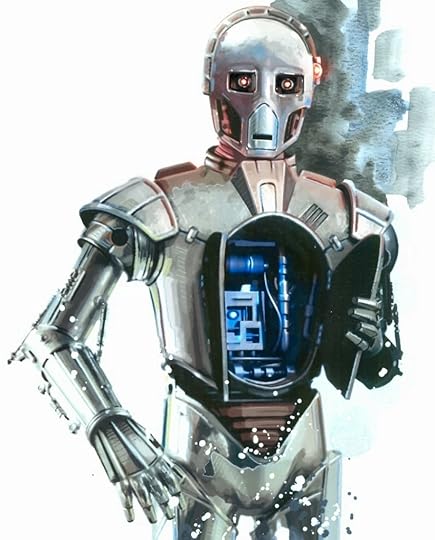 BLX-5, by Brian Rood, from the Star Wars Essential Reader’s Companion.
BLX-5, by Brian Rood, from the Star Wars Essential Reader’s Companion.Because that is how apt the idea of ‘Glup Shitto’ is to the Star Wars universe. Not only are there so many of these niche characters, not only are they beloved by whole dozens of fans, but some of them genuinely have names that you’ll get looks for saying in public.
I love Bollux as a character. His name also makes me laugh every time I think of it. But I love the concept of the Glup Shitto for more than that. Because no matter how obscure the Glup, no matter how niche the Shitto, there is never just one fan. There are always a handful of people who love that same character, for whom that one Transformer they had as a kid who never even cameoed in a heartbeat of a cartoon or comic at the time is their absolute favourite thing. And some of these handfuls of people are now the ones making Star Wars and its ilk – and so these niche characters are getting those moments of spotlight. Look at The Meep in last year’s Doctor Who, or the Corporate Sector in Andor, or any of a dozen less obvious examples: forgotten, obscure ephemera given new life for a new audience.
I’m not trying to advocate for the over-reliance on the past that has crippled so many shows and series in recent years (cough cough Doctor Who). I’m not talking about relying on nostalgia. I’m talking about people who love a weird, niche thing finding opportunities to show how much they love that thing. And because of those fans, because of those communities, because of nerds coming together, those weird little clans can come together around that weird little thing they love. They can talk, they can collaborate, they can shoot the Shitto all day long. And that’s just great.
Whoever you are, reading this, you have at least one Glup Shitto. You may not realise it, but you do. Think about it. Let me know who it is, and where they’re from. I guarantee that you won’t be the only one.
June 8, 2025
The Owl Takes Flight
So. How’s that book launch going, then?
Pretty well, in summary. Thanks to – or quite possibly despite – my relentless spamming of every social media thing I still use with cover photos and memes, I’ve shifted over 100 books in the last few days, which is fantastic. Sure, Blackbird and Nightingale both being free helps, but it’s still extremely heartening. What is almost the most heartening is that more people have downloaded the second Boiling Seas book than the first – which means, I hope, that said people have already read Blackbird and are coming back for more. Which means I probably did write that first book decently well; a good bit of news indeed. Nightingale has never historically sold very well – I think being a sequel just makes that harder – but now there’s something to follow it up, maybe that’s going to change.
And while all the different subcategories make these rankings a little meaningless, it’s still nice to see this.
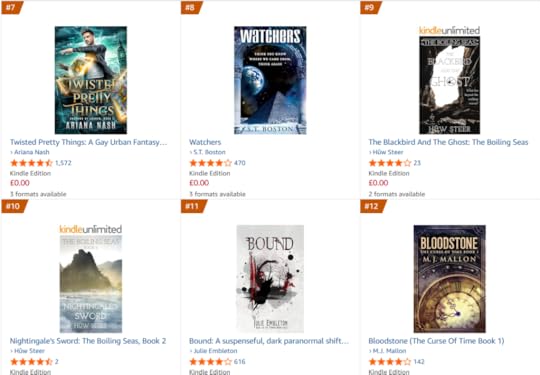 ‘Fantasy Adventure Fiction’ free rankings, 8/6/25
‘Fantasy Adventure Fiction’ free rankings, 8/6/25(It does make me question Amazon’s data, though – why is Blackbird ranked higher than Nightingale when it’s sold fewer copies this month? Weird. But I’m not complaining.)
Have I sold many copies of The Owl in the Labyrinth? So far, 5. Which doesn’t seem like many but I have to remember that this is the third book in a trilogy: the only people who are going to want to buy it right now are people who’ve already read books 1 and 2, and even if they read at lightning speed most of those downloading them for free this week will absolutely not have had time to do that yet. Hell, even those who have picked up Owl won’t have finished it yet – it’s 700 pages long, after all! This trilogy took a long time for me to finish writing and it’ll probably be a long time before people are finished reading. And that’s just fine with me. Hopefully the Boiling Seas just being a complete trilogy will capture some more interest than when it was unfinished – I know there are readers out there who don’t want to start anything that doesn’t have an end, lest they languish in cliffhanger hell forever. If you’re one of them, good news: I don’t intend to leave you waiting with any of my books.
So if you’re one of those people finishing the Boiling Seas trilogy, thank you. If you’re curious enough to grab that second book, even, thank you. And if you’re just starting… welcome aboard. I hope you feel like finishing the journey, because now you can.
And if you haven’t yet visited the Boiling Seas? Get in here quick, the sales are almost over!
It’s not much. I know it’s not much. But every time someone picks up one of my books it’s a good feeling. I am now of course extraordinarily nervous about what people are going to think of these books, especially Owl, opinions on which I currently await from a couple of reviewers… but that’s par for the course. The book exists. People are reading it. That, right now, is more than enough.
June 5, 2025
READ THE BOOK
The Owl in the Labyrinth is available NOW.
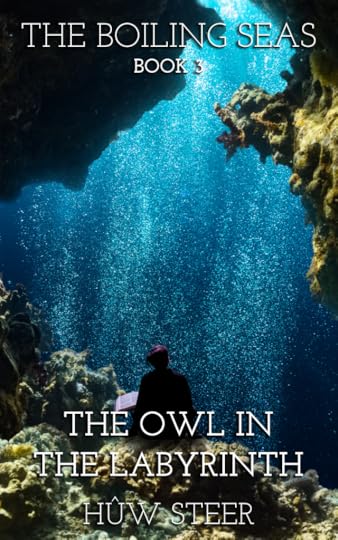
Go and read it. Go pick up The Blackbird and the Ghost and Nightingale’s Sword for free, and then grab Owl too. Get the entire Boiling Seas trilogy.
There’s a whole adventure out there waiting for you right now. Throw yourself into this weird world of mine.
June 1, 2025
Read The Book – The Owl in the Labyrinth, June 5th 2025
Let’s get one thing out of the way first:
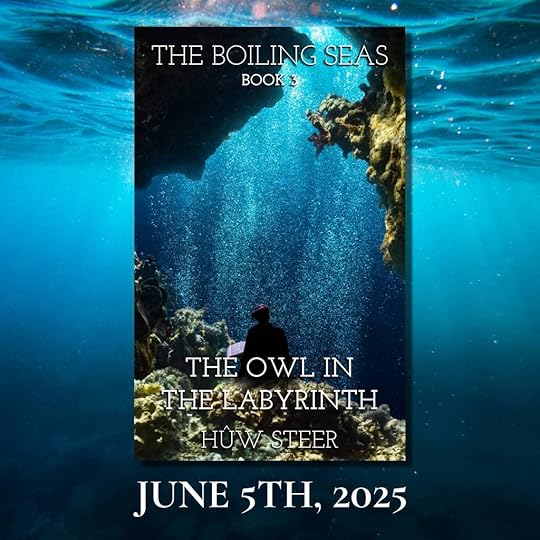
“We’re stuck in the middle of the Boiling Seas,” Tal said, “surrounded by soldiers, at the mercy of a tyrant and one of the most powerful magicians in the world. We’ve got no weapons, no friends, and no way out.”
“Exactly,” said Lily. “It’s going to be so much fun.”
Tal, Max and Lily might have sailed the deadly Boiling Seas, explored their mysterious islands, even flown through their steamy skies – but they’ve never ventured underneath them. Until now.
Because Max is trapped, surrounded by the very secrets she and her friends have been hunting – but while she unravels the mystery of the Scrolls, Tal and Lily are more concerned with getting her back alive.
It’s only a journey into the most inhospitable environment on the planet: an ocean of boiling water, floored with molten rock and filled with steel-scaled sea serpents. And it’s not like the most powerful man on the Seas is trying to seize their secrets for himself at the same time.
What could possibly go wrong?
I’ve spent the last few months getting this novel in order. I’ve formatted and reformatted and edited and tweaked. I’ve reached out to people with advance copies, I’ve posted promo, I’ve designed covers, I’ve uploaded manuscripts. And I looked, last week, at my drafts on KDP. I realised that, apart from publicity, I’d done just about everything. And then I looked at the calendar, and wondered why the 5th of June was ringing a bell.
Almost 6 years ago, on the 5th of June 2019, I released The Blackbird and the Ghost. And since the book was ready, and since I knew that I’d always be annoyed with myself if I missed the opportunity… I thought ‘what the hell’, and hit the pre-order button.
The Owl in the Labyrinth will be released on Thursday the 5th of June 2025.
And you can actually order it now, if you like, at least digitally: the pre-orders are entirely live and presumably working, given I’ve had to cancel multiple purchases of my own work while trying to copy the links. And unlike The Blackbird and the Ghost, the actual physical book will also release on the 5th. And, whoo boy. It’s a big one.
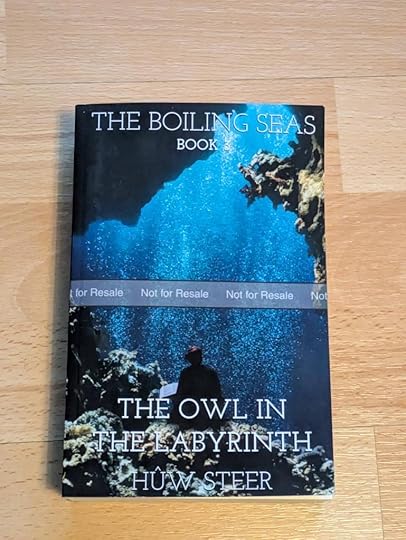
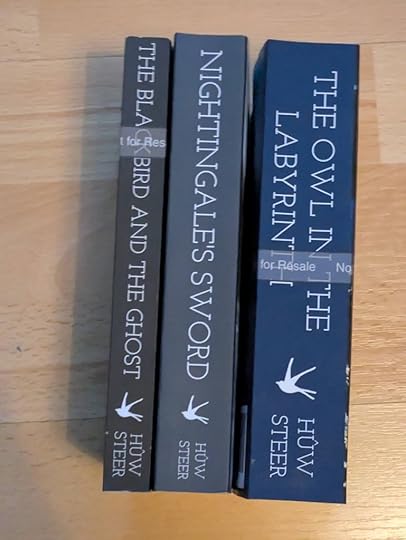
I am, as they say, in awe at the size of this lad. This absolute unit of a book is almost as long as The Blackbird and the Ghost and Nightingale’s Sword put together; it is bigger than two Blackbirds by a good margin. I knew that in terms of word count, obviously, but it’s another thing to actually see it. And hold it. I need a bigger bookshelf for my own work now. So if you want a Very Large Book then please: follow those links, and pre-order/wait until Thursday and get a copy.
‘But Hûw,’ I hear you cry, ‘I never actually read the first two books in the series!’ Then this piece of information will be very helpful: as of Wednesday the 4th, the ebooks of both The Blackbird and the Ghost and Nightingale’s Sword will be available for FREE. (Until Sunday the 8th.) This means you can have the entire Boiling Seas trilogy for the price of one book – and if you read fast enough, you can pick up books 1 and 2 on Wednesday and be finished in time to start The Owl in the Labyrinth by the time it actually comes out!
It’s a bit surreal, honestly. Obviously it’s not taken exactly 6 years to create this trilogy – it took a while to write Blackbird in the first place, after all – but for those of you, dear readers, who have actually read Blackbird and Nightingale it’s a nice bit of circularity. And I think back to who I was 6 years ago, and my mind boggles. Never mind who I was 9 years ago when I first started writing this series. The Hûw Steer of 2019 was barely out of university, still looking for a proper job, only recently in possession of a beard, even. 6 years on… and I still feel like I haven’t grown up, despite the fact that I’m married, that I have new friends, that I’ve travelled the world, that I’ve led a fair bit of life.
It feels particularly strange looking back at Tal Wenlock, 9 years after first writing him. I wrote him as a few years older than me; now he’s a few years younger. The journey I sent him on, and Max, and Lily, hasn’t been that long for them, for all that they’ve crammed an awful lot of adventure into it. But it has for me. I love this trio dearly. I love writing them. I hope that some of you, and some of the rest of the world, might enjoy reading them. I think that’s why I write, really: so I can share these worlds and words I love with other people. I tell stories. If you’ve ever listened, thank you.
So yeah. In summation: free books Wednesday, new book Thursday. Buy it. Read it. Enjoy it.
May 25, 2025
Owl Update #3: The Proof
Well, that took far too long. But then it always does, every bloody time I have to format a paperback.
I have been sitting here all day – and I do mean all day – transforming The Owl in the Labyrinth from the ebook manuscript into its printable, tangible form. You’d think that in this modern day and age it wouldn’t be that difficult: document has words in, books have words in; KDP knows this, takes one, makes the other. Some transformative fiddling about in the middle to make it look right, sure, but it should be simple.
Instead, I want Microsoft to bring back Clippy, the Office Assistant, so I can throttle him to death with my bare hands. If you can even strangle a paperclip. How does that little guy breathe?
Resize the paper, change the font: fine. Remember to change the line spacing so suddenly the book is 300 pages shorter (seriously!): also fine, actually quite helpful, even. Add the table of contents and the title page. Change the size and font of the page numbers: fine, because all the sections are linked together, so changing the first one changes the lot. Its going great. So far.
Change the headers, so that it’s author name/title name repeating every other page, like my other books. Except that because each section used to have its own header – Chapter 1, Chapter 2, etc. – they’re not linked together. So I click through 70 chapter headings, changing each one individually. Annoying, but at least that’s done, so now I can – what’s that? Half the page numbers have disappeared? Every other page is missing? Right. Because I’ve messed with the headers, the footers now decide to mutate. So I put those back too, and it all looks good. Great.
Then I remember that the on-page chapter numbers also need to be resized and moved. So I scroll through again, section by section, and change them all. Fine. While I’m at it, I update the table of contents so the part numbers are up to date – and the frontmatter numbering too, which is separate ‘cause I like i, ii, iii etc. for that part.
What’s that? Half the page numbers have disappeared again? Give me strength. But some fiddling puts it right. The map goes in, the ISBN goes in, and I have a ready manuscript! I feed the numbers into KDP and find out how wide the spine of the cover needs to be – aha, I think smugly, it’s a good thing I already made the cover. This will be an easy fix: just make it a bit wider. And it actually isn’t so bad, especially once I realise that the entire cover of Nightingale’s Sword is for some reason hiding underneath this one. The program starts running a lot more smoothly once it’s gone. Funny, that.
I have a cover! I have a manuscript! Up it gets loaded to KDP; a quick glance at the previewer and –
Why is there an extra blank page at page 8? That’s not in the Word document. I check. I check twice. I upload it again. It’s still there.
Ok, let’s take a blank frontmatter page out and see what happens – why are there now 707 pages, when there were 709, and I have removed one of them? And why, when I upload it to KDP, is there still an extra blank page but now in a different spot? I can’t count them properly, because this is frontmatter: the actual page numbers haven’t started yet because I already made them that way.
I remove pages, I add them, I change back and forth and every single time there is either an extra page on KDP, a mysterious phantom page on Word, or both!
It took hours, dear reader. Literally. I eventually managed to luck on a frontmatter alignment that everything liked (the book is now 705 pages long; why that worked I have no idea), and got it uploaded again. I looked at the printing costs…
Ye gods. This is a big book. I knew it was going to cost more than my other ones. But it’s a lot. I just hope it actually looks good, which I’ll hopefully find out by next weekend when my proof copy arrives.

Because it’s coming. A hard copy of The Owl in the Labyrinth will be in my hands within the week. And that is exciting enough to make all this faffing about and frustration worth it.
All I need now is people to read it. If you want to, let me know. If you want to read it early, let me know too.
May 18, 2025
(even) Strangers In Fiction
This week’s blog has some required reading. Well, listening. Or watching. Of the 6th episode of the Strangers in Fiction podcast, on which the excellent Sora Sullivan and Saffron Asteria (of the excellent Indiosyncrasy) talk about writing, and about books. And this week, among various other topics, they’re talking about my book: The Singer; my cosy fantasy novella about the magic of the countryside, and also maybe some actual magic. To summarise: they liked it. (Hooray!)
So first things first: go and listen to/watch Strangers in Fiction, because it’s very fun, and because without listening to it you may not understand what’s about to happen here. For while discussing The Singer Saffi and Sora had questions – about the story, about the writing process, about some other stuff as well.
If only there were someone who could answer all of those questions…
That’s right; I’m the literary equivalent of a reaction YouTuber now. Let’s get into it.
And yes, that is a hardback copy of The Singer in Sora’s hands; yes, you too can have one of those if you want. They do look rather nice.
20:02
Sora: “I was scared by the accent mark; I did not know how to pronounce Hûw’s name…”
Saffi: “I think it’s Welsh.”
It is indeed Welsh, though the accent tends to only make a difference if you’re saying it in a Welsh accent. Small children usually call me ‘Q’, which honestly could be worse.
22:37
Saffi: “My dad calls that ‘getting up at the crack of a sparrow’s fart,’ and I still don’t know what that means.”
Sora: “Sparrows are early morning birds… so if sparrows are farting they’re waking up for the day?”
Correct! Depending on which dictionary you look at it originates from somewhere between 1820 and 1890, probably in Yorkshire.
…I never said I was only answering questions about the book.
27:49
Saffi: “…it really encapsulates a small British village… at the time of reading this I was very homesick, and I was like ‘ah, this is nice’.”
Well I’m glad that comes across, because that was the point: The Singer is very much an idealised, fantasied-up version of the little villages where I grew up in rural Herefordshire. The fields, the churches, the pubs, the people… it’s all from my childhood. Bonus fact #1: half the background characters in this book are named for actual childhood neighbours of mine. It certainly helped them feel real to me.
30:05
Saffi: “It leaves itself open to more from that universe, I don’t know if he’ll ever do that – I assume that Hûw’s going to be listening to this –”
Correct.
Saffi: “– if you are, Hûw –”
I am.
Saffi: “ – I would read more of this.”
I’d write it, honestly. I left things fairly open at the end of The Singer, not with a specific intention to write a sequel – like Sora says at 25:00ish,it’s an ambiguous ending and that was intentional. But just because I didn’t want to lock that story down into ending happily or sadly doesn’t mean that I’ll never go back to Quern. There’s a whole village of characters there to explore, after all, and The Singer’s only short, so most of them are sketched only briefly.
So: no plans for a sequel, but definitely not ruling it out.
32:40
Sora: “I noticed that the main character wasn’t named until he started interacting with other people, and I thought that was a really interesting touch. It was obviously an intentional choice, and I thought it did a lot to draw attention to the isolation of the main character from the rest of society…”
Saffi (at 33.54) “I do wonder if that was an intentional choice.”
Heh. Yes. Definitely intentional. Not (at least originally) because I just started writing the story before bothering to name him, and only realised when I sent Tom into town that I couldn’t just refer to him as ‘the farmer’ when half the rest of the village were also farmers. But I did leave that ambiguity at the start for a reason: Tom is a farmer (among other things), and he is a bit of a solitary man, and when he’s on his own with the dog there’s no need to think of himself as anything else. His name is part of an identity that only really exists when there are other people around.
Or something like that, anyway.
Bonus fact #2: I named Tom’s dog before I named Tom. I had a collie growing up, but Patch was a boy – but my friend Will’s collie was a lively girl named Roo. So if you ever read this, Hodgeman, yes, I did steal your dog.
33.11
Sora: “Kern? Cairn? I’m not sure how to pronounce that.”
Saffi: “In my head I pronounce it as ‘Cairn’. Whether that’s right I don’t know… Hûw, you tell us!”
Bonus fact #3: Quern was originally called Whetstone, because that’s a real bit of London and I cannot get over how much like a fantasy village it sounds. So much so that after writing The Singer and then sitting on it for ages, I proceeded to write a children’s book, The Fire Within, and call that village Whetstone too. I ended up publishing it first, so The Singer’s village name had to change to Quern. A quern-stone of course being a round stone used to hand-grind grain, like a vaguely portable mill – i.e. a vaguely fantastical-sounding farming equivalent to a whetstone/grindstone.
So how is it pronounced? In my head it’s ‘qwern’, and the Cambridge Dictionary appears to agree with me, which is convenient because I absolutely did not check until this exact moment. But I don’t mind how you say it, honestly. Coming up with wildly different pronunciations of words that don’t exist is part of the essence of reading fantasy.
34:01
Saffi: “When I asked him to do… a written interview for Indiosyncrasy, from the prompt I gave him it spurred on a few thousand word story because he couldn’t stop writing it… he just loves telling stories.”
At the time of writing ‘The Package’ is currently at 9660 words and absolutely nowhere near finished. If you’re reading this, Saffi, give me more prompts; this one alone made me dig out a character I hadn’t touched in over a decade and I’m loving it.
So that’s that. Thank you so much to Saffi and Sora for taking a punt on The Singer; I’m very glad you liked it and very grateful that you talked about it. Please, dear readers, check out the rest of Strangers in Fiction, which you can get in all the podcast places; have a browse through the Indiosyncrasy site for all your indie book needs; have a read of Sora’s work-in-progress book Interdimensional Bachelorette. These are lovely people doing and writing lovely things for the indie writing community. They’re great.
And check out The Singer, if you like. This lot liked it. You might too.
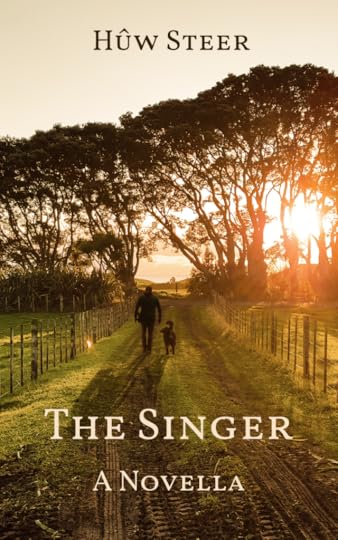
May 11, 2025
Owl Editing #2 – Maps
Right: I was ill this week and stuck at home, which meant that I really didn’t have an excuse to not get any editing done. I did also have work to do, alas, largely of a literary bent but not directly on my own manuscript. More editing, more proofing, just not mine.
But I got it done. I finished the edit list for The Owl in the Labyrinth, at least for now: I want to run a few bits past my ever-suffering proofreaders to see if I have in fact managed to properly do what I’ve intended. I have expanded the ending, with an extra chapter and a half or so of breathing-room before the grand finale. I have gone back and seeded just a few extra hints at one ending reveal, just to make sure you, dear readers, might see it coming, or at least won’t feel like it came out of nowhere when it does. I have reviewed some fight scenes, I have added some gods.
I have run out of words to finesse for the moment, which unfortunately means I have to move on to the next vital step. I want to get an eBook version of the book ready and formatted so I can send it out to whatever mad handful of reviewers have either already read the first two Boiling Seas books or are willing to take on an entire trilogy. I expect this to be a fairly small number of people, but that’s all fine with me. (If you are one of these people, or would like to be, please drop me a line!) But to do that, I need three things:
A finalised manuscript – which is almost thereA front cover – which was actually done well in advance for onceThe map at the startThis means that I, writer extraordinaire, must draw the map. This presents a problem, because I am not very good at drawing… well, anything, really. And the place that, for this book, I actually need to map is not exactly conventional. It’s a location. It’s just got absolutely none of the other conventional features of a map, like coastlines, or settlements, or hills. On the one hand, I’m rubbish at drawing these; on the other I’ve still got to draw the other stuff that goes in their places, which might be significantly harder. And I’ve got to make it both look hand-drawn and not look like I hand-drew it, and still be clear enough to read and understand – and I need to do all this, and add in enough detail for the map to be useful, without actually spoiling some significant portions of the book. I’m resigned to doing so very slightly, because if I just left off all the interesting stuff then it would be the world’s more boring and useless map, and it’s not like I’m going to explain what all these weird little annotations mean – you’ll have to read on and find out – but there are whole sections of this map that I simply cannot draw yet at all, lest I give a big chunk of the game away.
Am I overthinking this? Probably. Most people will likely glance once at the map and never again. But I still want it to be there, and I still want it to look good. I regret not doing a map for Nightingale’s Sword; maybe I’ll go back and add one in to a future edition some day. This is the end of the trilogy, though. I want all the fantasy bells and whistles I can squeeze in, and that means this weird, not-really-a-map-at-all map. And I’ve got to do it.
Because maps are important, even if they are just set-dressing. They give that sense of reality, of this being a real world that’s really lived in, with real places and real geography. Fantasy is full of strange new worlds, and having those visual guides to even the smallest sliver of those worlds has always been a thing of great immersion for me. I love a map. I love the idea of this map, even if that may not translate to paper.
So I’d better rough up a few more drafts to see if it’s going to work.
May 4, 2025
Owl Editing: Update #1
May the Fourth be with you all.
My writing brain is tired, so this is now an Owl in the Labyrinth progress report, because I have in fact spent most of the day doing edits on The Owl in the Labyrinth. The number of notes in my proofreading doc that are now highlighted in green is becoming more and more satisfying: for one thing, I’ve fixed all of the actual spelling and grammar mistakes, of which there were fewer than I’d feared. I’m well into the meat of the proper feedback, which is largely fourfold.
First came the Deity Edit. It was pointed out that my characters had been doing a lot more casual blasphemy/‘by the gods’-ing than in the two previous books, which I attribute, in fairness, to the fact that they’re all under a lot more stress in this one. Something to do with sparring with tyrants and evading the monsters of the deep, I don’t know. Anyway, rather than leaving my pantheon/s as generic and faceless as I had before, it was time to add in some actual gods. This isn’t a book that gets heavily into religion on any level, so don’t get too excited if you like a good fantastical creation story or myths and legends, but I’m quite pleased with Vedova, widow-goddess of sailors, to whom they pray that they might actually get back home to their own spouses. (No god would ever create something as deadly and inhospitable as the Boiling Seas, goes the logic: there is no sea-god for them to worship.) A light sprinkling of acknowledged churches and some more specific iconography will do for now – though there are of course many deceased and forgotten pantheons for me to explore in future tales of the Boiling Seas and their history…
I then have some fight scenes to trim and tweak, and some extra hints to drop for one elongated plotline that I’ve resolved at the end of this book – I’ve been setting it up for a while now, but apparently some of my hints have been too subtle, as I mentioned the other week. But the main thing I have to tackle, which I’ve made excellent headway on today, is the ending. Not the drama, not the epic, climactic conclusion (which I’m quite pleased with and is, I’m informed, at least ‘good’), but the part after that. The downtime. The breathing-out after the tension is gone, the breathing-room for everyone to come to terms with what’s just happened. I already had a chunk of that on the end – no way to avoid it with so much to resolve in this trilogy-end – but apparently I need a little more.
And honestly, it’s been lovely to write so far. It’s been whole months since I last properly wrote new Boiling Seas content, and it always feels good to write scenes that allow my characters to relax. It’s relaxing in itself. This book is far too long already, sure, but another thousand words or two either way isn’t really going to change that, and I’d rather have a little too much than leave you, dear readers, unsatisfied.
Still a bit more to go on that front – another scene or two and I think it’ll be good – but I’m happy so far. It’s coming along. Soon it’ll actually be here, which is slightly nerve-wracking. It’s not every day one publishes the end of a trilogy, and I am very bad at marketing. I’m not sure how easy it’ll be to find reviewers who’ll take on a whole three books, not just one…
April 27, 2025
Wonder – A Matter of Perspective
I like having little guys around. I have done since I was a kid, and one of the great things about adulthood is that while your parents may roll their eyes or even tut disapprovingly, nobody can stop you from continuing to be a child at heart. More specifically, my parents and now my wife get to put up with my occasional, continuing project of conjuring adventures for this little fellow:
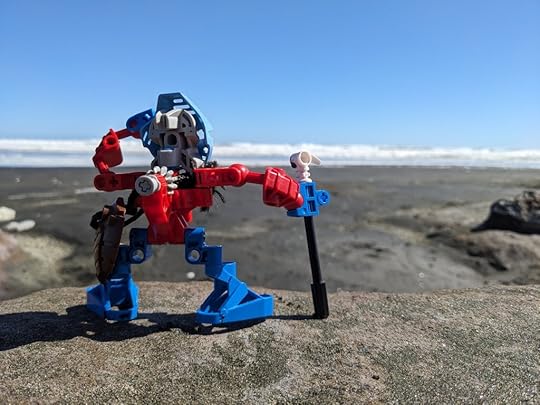
This is Takua. For those of you who, like me, were children at the turn of the century, LEGO’s Bionicle series may be familiar to you: mighty heroes questing after masks of power and fighting the forces of darkness, in the form of buildable plastic robots. An advantage of working with LEGO for a living is that I can now happily continue collecting said robots to add to the ones I had as a child, including this little guy. This particular character works as a Chronicler; he travels around his island and beyond recording stories and important events. And so before one family holiday a few years ago I had the bright idea to bring him along, because I’d been looking at some rocks on a beach and thinking that while they might be just a pile of stones to me, to something smaller they’d appear a little more dramatic.
And I think that turned out to be true.
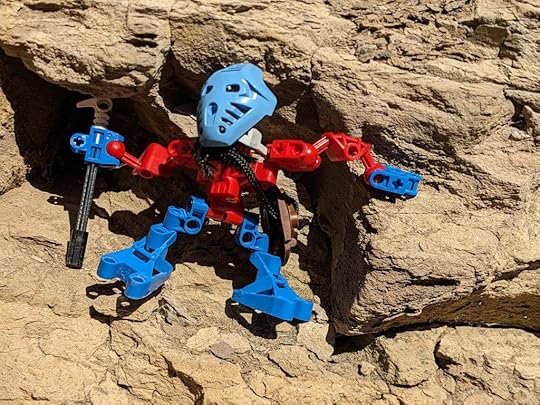 Defying death at every step!
Defying death at every step!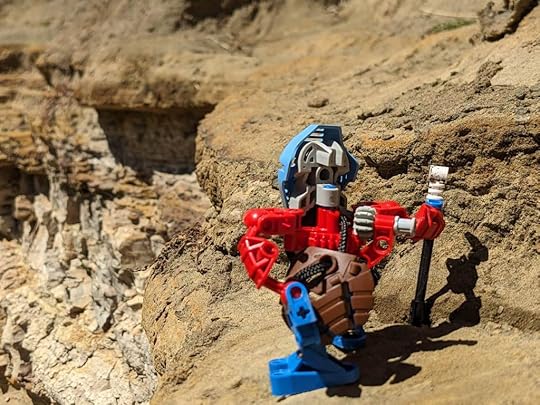 Definitely not approximately 2 feet off the ground!
Definitely not approximately 2 feet off the ground!So Takua has accompanied me to various places now, where I have indulged this occasional desire to play with toy photography and to irritate whoever I’m on holiday with by slowing them down on walks. Because when you’re four inches tall, a stream is a mighty river; a weed is a colossal tree; a big rock is a towering cliff-face. A journey of a few metres is a multi-day odyssey. A bit of interesting lichen is barely worth a glance, if you’re the size of a human, but to Takua, these rust-red boulders are fascinating. These weird mushrooms we found are interesting enough to look at – but imagine if they were literally knee-high!
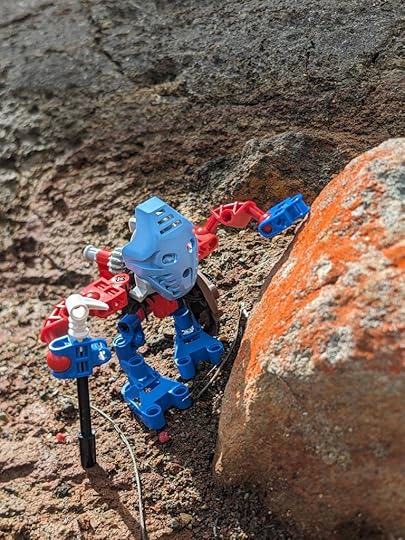
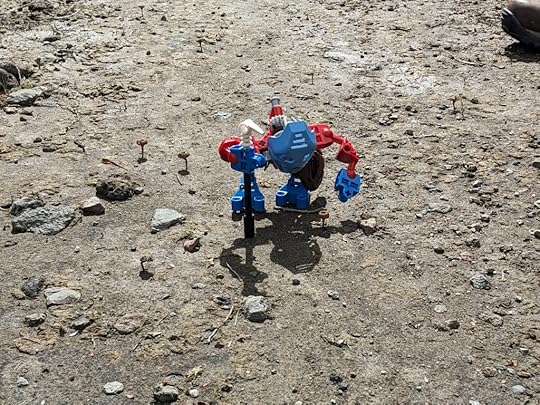
Scaling up these environments, transforming them in the context of Takua’s view, is immensely satisfying and fun to do. He always comes home safely from these grand adventures, of course, but it doesn’t always look like that’s going to happen. Thankfully he has a Giant Sky God to pluck him from harm’s way if necessary. And also to repeatedly put him there.
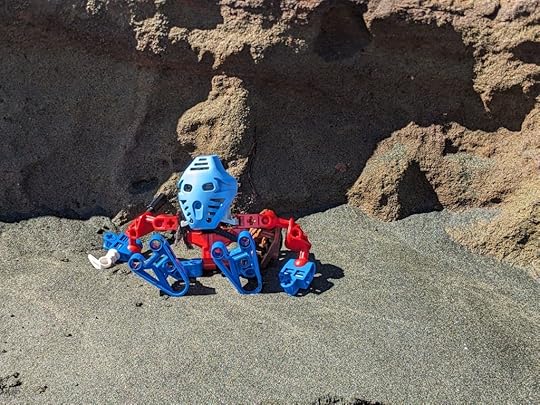
And this is, I think, at the very heart of good SF&F: looking at reality and recontextualising it. What looks normal or mundane at first glance can be turned into something weird beyond imagining with a little effort and tweaking. Look at how many props and costumes are just ordinary things rebuilt. There are levers on the bridge of the starship Enterprise that are just barcode scanners glued to a bit of wood. Qui-Gon Jinn’s Space Radio is just a razor handle. The lightsaber – one of the most iconic bits of sci-fi equipment ever created – is some bits of old camera welded together. And so too are landscapes and bits of environment.
A crumbling archway in a forest can become a gateway to anywhere you’d like. A stream on the riverbed of a gorge in Morocco can become a mighty, surging river on a planet seared by an unforgiving sun… as it did for me in The Scar, a long story turned short story that I really must revisit and expand back into the novel it was rapidly becoming.
 A tiny stream can a mighty river make.
A tiny stream can a mighty river make. The Giant Chair of Doom, however, is a mystery that none dare explore in full…
The Giant Chair of Doom, however, is a mystery that none dare explore in full…A lighthouse can become a towering beacon of knowledge like the Lantern in the Boiling Seas. A strip of woodland can become a hostile jungle. A bit of rock two feet high can become a treacherous cliff face for a little plastic robot.
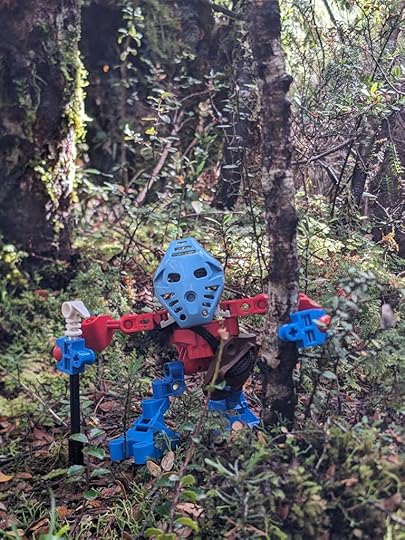 Plants are fascinating things, especially if you consider what they’d be like scaled up.
Plants are fascinating things, especially if you consider what they’d be like scaled up.Building fictional worlds can simply be a matter of looking at the real world in a different way. And pocketing Takua for a little adventure is a great way, I find, to do just that: to see things differently, to turn the mundane into the wondrous. Anything can be amazing if you just see it differently. Then all you have to do is write about it.
April 20, 2025
To Set Up or Not to Set Up
I have come to the conclusion, having just hastily written up an RPG session that revolves around the uncovering of the Big Scheme, that writing mysteries is hard.
Not just mysteries, I should say. Foreshadowing in general can be bloody difficult. Because fundamentally, I, the writer, am in possession of all the facts: I know precisely where I want the plot to twist, exactly what I want to be revealed and when, whether it’s a romance or a con or a plot to blow up a planet. I know what’s going on. You, dear readers, or players, or whoever you are, do not. But for those reveals to be successful, for those payoffs to feel good and deserved, they have to be set up right. And that means a careful balance of not writing as much as writing.
No plot twist should come entirely out of nowhere. To paraphrase myself in a recent interview, not everything need be a Chekhov’s Gun, but if Chekov is one of your characters then you should at least establish that he’s a competent marksman. A writer should sow the seeds of what’s to come, to make these things feel earned when they get resolved… and also to reward the eagle-eyed reader who connects the dots a little early. Or indeed to throw off those who connect the wrong dots. Either’s fine with me.
In my feedback edits of The Owl in the Labyrinth, on which I am currently working, one thing that came up was a plotline that didn’t feel like it was set up fully. I had been conciously dropping hints throughout the book of how it was going to resolve – hell, I started doing so back in Nightingale’s Sword – but it seems I didn’t do so clearly enough. And that is fine, and another reason for getting good proofreaders: I am very happy to go back and tweak things, to foreshadow more heavily. It takes another set of eyes to get that balance right, sometimes. Because like I said: I know everything, but the reader does not, and so it’s very easy to go too light on the setup without realising it.
Equally, I’m trying to avoid telegraphing things too heavily: it’s just frustrating as a reader to realise exactly what’s coming and then have to wait 200 pages to actually have it confirmed. Balance is key.
And so when I’ve been pulling together this RPG session for tomorrow, I’ve been trying to strike that balance. I want my players to at least start connecting the many dots I’ve left for them. I want them to make the realisations, at least some of them. They’re the characters, after all, not just the readers – it’s their story, their mystery to unfold. And it’s even harder to find that balance of telling and implying as a result. I have seeded dialogue, I have set up clues, I have even drawn maps and left hints in those.
We’ll see what happens. But by the Golden Throne, if these idiots don’t pick up on the suspiciously named, suspiciously operating and suspiciously existing shipping company by the end of the session, someone’s getting thrown out of a window. Whether it’s in or outside of the game is up to them.

